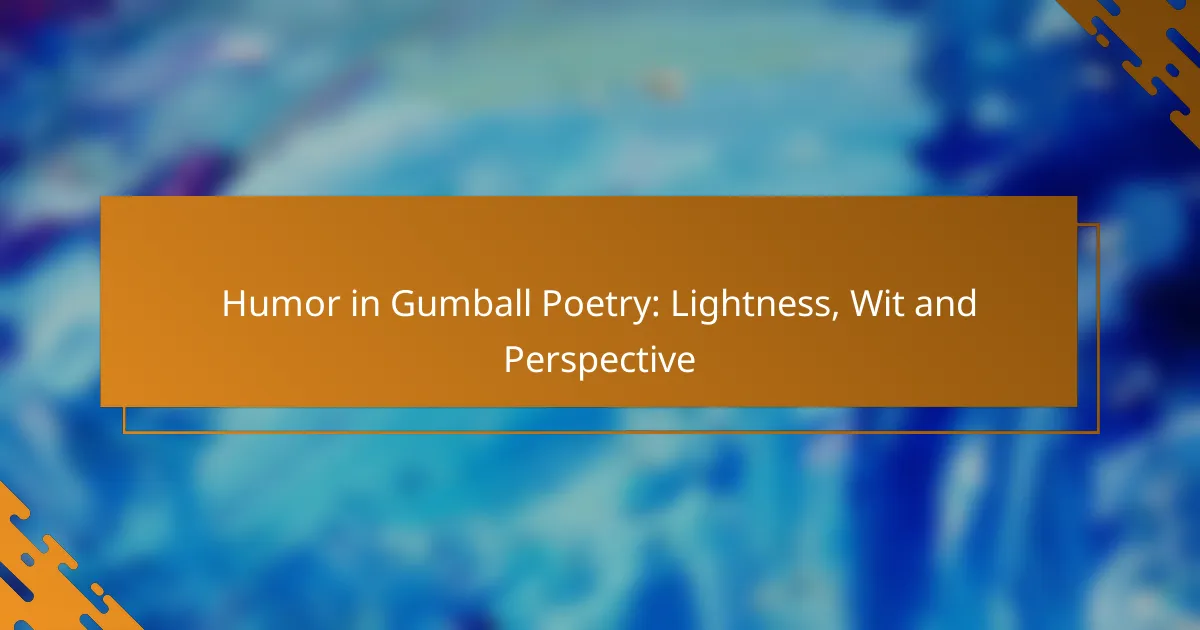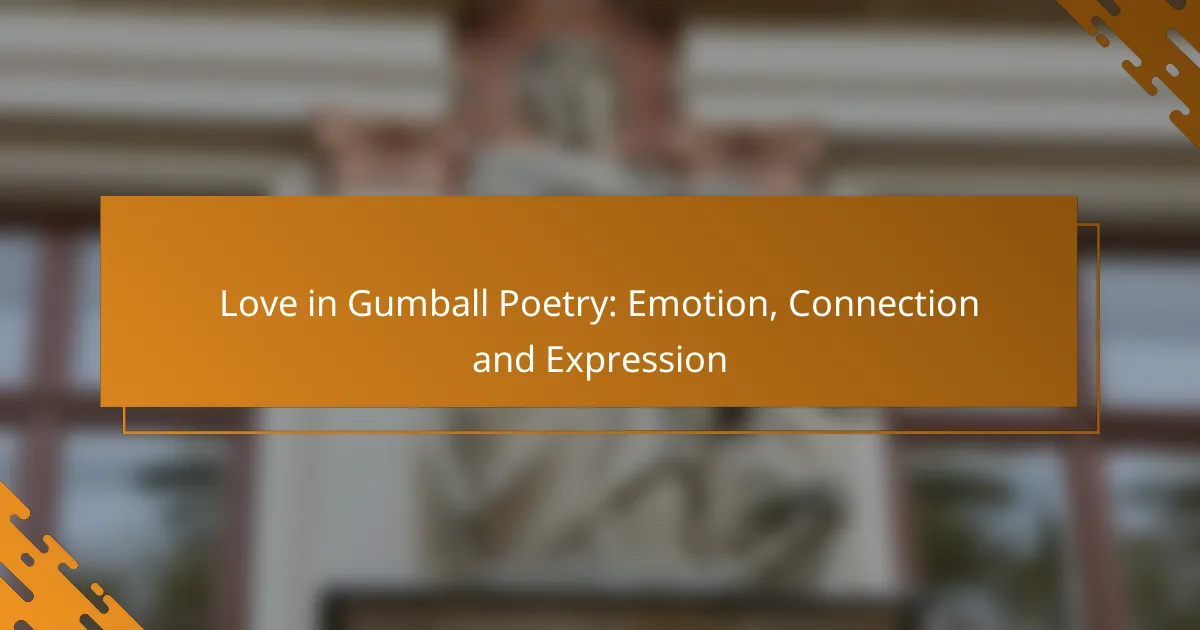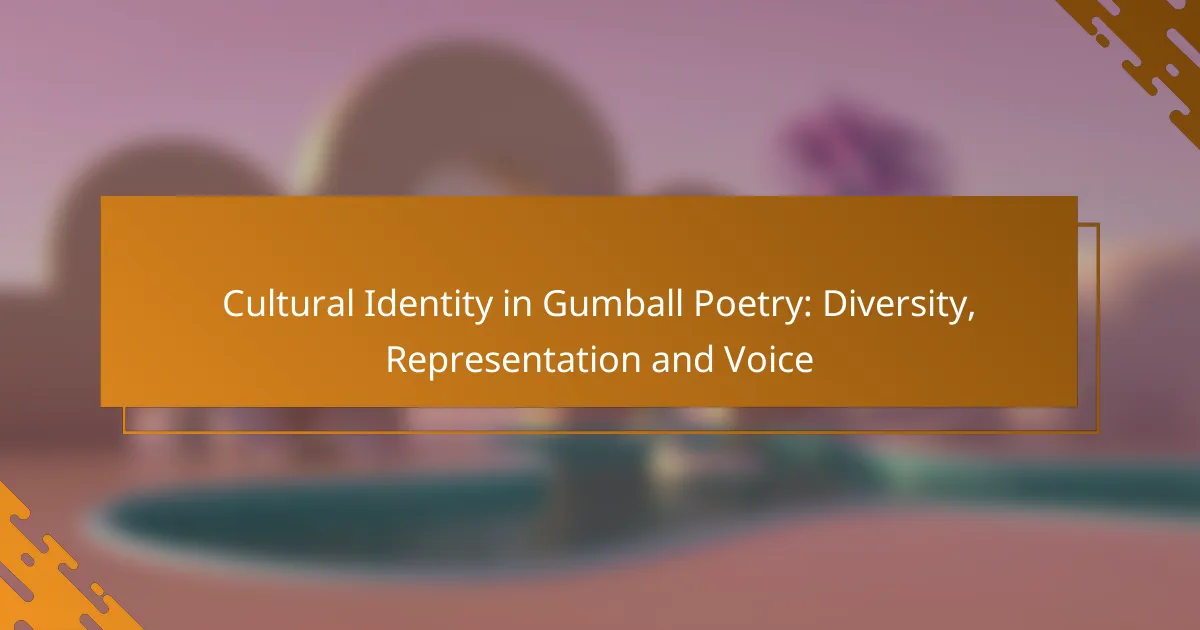Humor plays a vital role in Gumball poetry, infusing it with lightness and wit that makes the genre both accessible and enjoyable. By employing elements like exaggeration and surprise, poets create a playful atmosphere that invites readers to engage with everyday experiences in a fresh and relatable way.

How does humor enhance Gumball poetry?
Humor enhances Gumball poetry by infusing lightness and wit, making it more accessible and enjoyable for readers. This playful approach invites deeper engagement and fosters a unique perspective on everyday experiences.
Creates relatability
Humor in Gumball poetry often reflects common human experiences, making it relatable to a wide audience. By using everyday situations and adding a humorous twist, poets can connect with readers on a personal level.
For instance, a poem about the struggles of morning routines can resonate with many, as it captures the universal challenge of getting out of bed. This relatability encourages readers to see themselves in the poem, enhancing their emotional connection.
Encourages engagement
Humor serves as a powerful tool to engage readers, prompting them to think and react. When a poem elicits laughter or a smile, it creates a memorable experience that encourages sharing and discussion.
Poets can use playful language, puns, or absurd scenarios to draw readers in. For example, a Gumball poem that humorously critiques social norms can spark conversations about those very topics, fostering a sense of community among readers.
Offers fresh perspectives
Humor allows Gumball poetry to present fresh perspectives on serious subjects, making them more approachable. By framing difficult themes in a light-hearted manner, poets can invite readers to reconsider their views without feeling overwhelmed.
A poem that humorously addresses issues like anxiety or societal pressures can provide relief and insight, encouraging readers to reflect on their own experiences. This unique lens can lead to greater understanding and empathy among audiences.
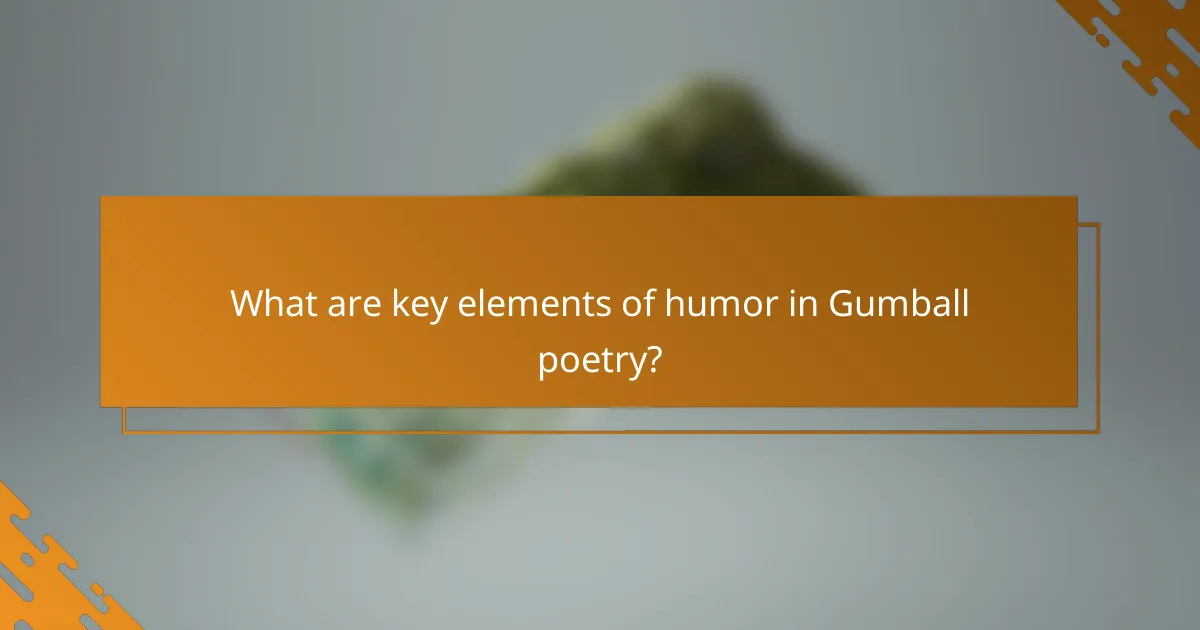
What are key elements of humor in Gumball poetry?
Key elements of humor in Gumball poetry include wit, exaggeration, and surprise. These elements work together to create a light-hearted and engaging experience, allowing poets to play with language and ideas in unexpected ways.
Wit and wordplay
Wit and wordplay are central to Gumball poetry, often employing puns, double meanings, and clever phrasing. This type of humor invites readers to think critically about language while enjoying the playful manipulation of words. For example, a line that plays on the dual meaning of “bark” can evoke both the sound a dog makes and the outer layer of a tree, creating a humorous connection.
To effectively use wit, consider incorporating unexpected twists in your phrasing or using homophones that can shift the meaning of a line. This not only entertains but also encourages readers to engage more deeply with the text.
Exaggeration and absurdity
Exaggeration and absurdity amplify humor in Gumball poetry by presenting scenarios that stretch reality. This can involve depicting characters with exaggerated traits or situations that defy logic, making them amusingly ridiculous. For instance, describing a cat that can recite Shakespeare while juggling fish creates an absurd image that delights readers.
When using exaggeration, aim for a balance that maintains believability within the poem’s context. Too much absurdity can confuse readers, while just the right amount can enhance the humor and keep them engaged.
Surprise and twist endings
Surprise and twist endings are effective tools in Gumball poetry, often leaving readers with an unexpected conclusion that recontextualizes the preceding lines. This technique can create a humorous punchline that resonates long after reading. For example, a poem that builds up a serious scenario only to reveal a silly outcome can elicit laughter through its clever twist.
To master this element, consider setting up a familiar situation and then subverting expectations with an unexpected resolution. This not only enhances the humor but also encourages readers to reflect on the poem’s deeper meanings.

How can I incorporate humor in my Gumball poetry?
Incorporating humor in Gumball poetry involves using lighthearted language, playful structures, and relatable experiences. This approach not only entertains but also connects with readers on a personal level.
Use playful language
Playful language is essential for creating a humorous tone in Gumball poetry. Consider using puns, alliteration, and whimsical imagery to evoke laughter. For example, instead of saying “the cat sat on the mat,” you might say “the frisky feline frolicked on a fluffy mat,” which adds a light touch.
Additionally, experimenting with unexpected word choices can enhance the comedic effect. Words that sound silly or create amusing visuals can make your poetry more engaging and memorable.
Experiment with structure
Varying the structure of your Gumball poetry can introduce humor through surprise. Try using unconventional line breaks, playful rhymes, or even incorporating lists to create a sense of rhythm that feels light and fun. For instance, a poem that lists absurd reasons for a cat’s behavior can be both humorous and relatable.
Consider mixing short, punchy lines with longer, more elaborate ones to create a dynamic flow. This contrast can enhance comedic timing and keep readers entertained throughout the piece.
Draw from everyday experiences
Everyday experiences provide a rich source of humor for Gumball poetry. Observing the quirks of daily life, such as the antics of pets or the oddities of human behavior, can inspire relatable and funny content. For example, writing about the chaos of a morning routine can resonate with many readers.
To make your poetry even more engaging, exaggerate these experiences for comedic effect. A simple trip to the grocery store can become a grand adventure filled with humorous mishaps, making your poetry both entertaining and relatable.

What are popular themes in humorous Gumball poetry?
Humorous Gumball poetry often explores themes that resonate with everyday experiences, making them relatable and entertaining. Common themes include childhood memories, social observations, and reflections on nature and animals, each infused with wit and lightheartedness.
Childhood memories
Childhood memories serve as a rich source of humor in Gumball poetry, often highlighting the innocence and absurdity of youth. Poets may reminisce about silly games, awkward moments, or the imaginative scenarios that children create, using playful language to evoke nostalgia.
For example, a poem might describe the chaos of a schoolyard game gone wrong, capturing the hilarity of a childhood mishap. Such themes resonate with audiences, reminding them of their own formative experiences.
Social observations
Social observations in humorous Gumball poetry often critique everyday life, using humor to shed light on societal quirks and behaviors. Poets may poke fun at trends, cultural norms, or the absurdities of adult life, making sharp yet light-hearted commentary.
For instance, a poem might humorously address the challenges of modern technology, illustrating the frustrations of dealing with gadgets that seem to have a mind of their own. This blend of humor and insight encourages readers to reflect on their own lives while sharing a laugh.
Nature and animals
Nature and animals are frequent subjects in Gumball poetry, where humor arises from the whimsical interactions between humans and the natural world. Poets often anthropomorphize animals, giving them quirky personalities that lead to amusing situations.
A poem might depict a cat’s misadventures as it attempts to catch a butterfly, showcasing the humorous disconnect between the animal’s intentions and its actual capabilities. Such playful portrayals invite readers to appreciate the lighter side of nature while connecting with familiar animal behaviors.

How does humor in Gumball poetry differ across cultures?
Humor in Gumball poetry varies significantly across cultures, influenced by local traditions, language, and societal norms. Each culture brings its unique flavor to humor, which can affect how Gumball poetry is crafted and appreciated.
Regional humor styles
Regional humor styles play a crucial role in Gumball poetry, as they reflect the distinct comedic tastes of different areas. For instance, Western cultures may lean towards irony and sarcasm, while Eastern cultures might favor subtlety and wordplay. Understanding these styles can enhance the effectiveness of humor in poetry.
In some regions, humor may be more direct and slapstick, while in others, it can be layered and nuanced. Poets should consider their audience’s cultural background to tailor their humor appropriately.
Language nuances
Language nuances significantly impact the humor found in Gumball poetry. Puns, idioms, and colloquialisms can vary widely between languages, making some jokes land perfectly in one culture while falling flat in another. Poets must be aware of these linguistic subtleties to create humor that resonates.
For example, a pun in English may not translate well into Spanish, where the wordplay loses its charm. Therefore, poets should either adapt their humor for different languages or provide context to ensure the joke is understood.
Cultural references
Cultural references are essential in Gumball poetry, as they provide context and relatability. Humor often relies on shared knowledge, so poets should incorporate references that their audience can easily recognize. This can include local events, popular figures, or traditional stories.
However, poets should be cautious not to alienate readers who may not share the same cultural background. Balancing universal themes with specific references can help create humor that appeals to a broader audience while still being culturally relevant.
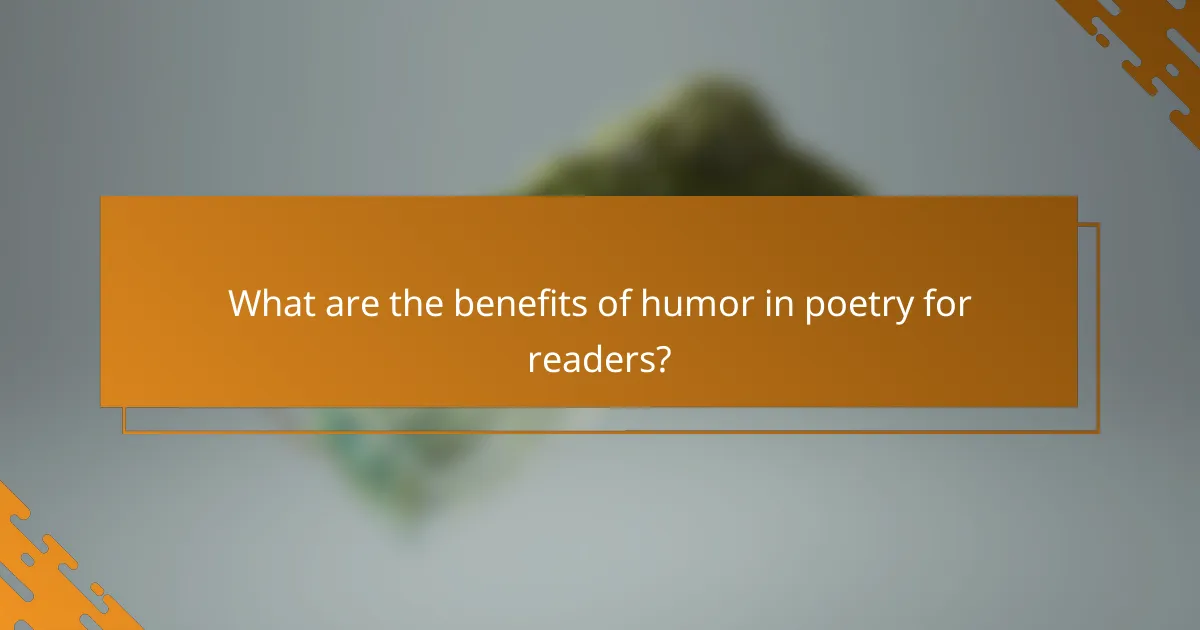
What are the benefits of humor in poetry for readers?
Humor in poetry offers readers a unique blend of entertainment and insight, making complex themes more accessible and enjoyable. It can lighten heavy subjects, foster connection, and provoke thought through wit and clever wordplay.
Enhancing Engagement
Humor captures attention and keeps readers engaged, encouraging them to explore deeper meanings within the text. When a poem incorporates humor, it invites readers to reflect on their own experiences while enjoying the light-heartedness of the language.
For example, a poem that uses puns or playful imagery can create a memorable experience, prompting readers to revisit it. This engagement can lead to a greater appreciation of the poet’s craft and the themes presented.
Facilitating Understanding
Humor can simplify complex ideas, making them easier to digest. By presenting serious topics in a humorous light, poets can help readers confront difficult emotions or societal issues without feeling overwhelmed.
A poem addressing loss might use irony or absurdity to soften the blow, allowing readers to process their feelings more comfortably. This approach can foster empathy and understanding, bridging gaps between diverse perspectives.
Building Connection
Humor fosters a sense of community among readers, as shared laughter can create bonds. When a poem resonates through its wit, it can evoke a collective response, making readers feel less isolated in their thoughts and emotions.
For instance, a humorous take on everyday life can resonate with many, sparking conversations and connections among readers. This shared experience can enhance the overall impact of the poem and its themes.
